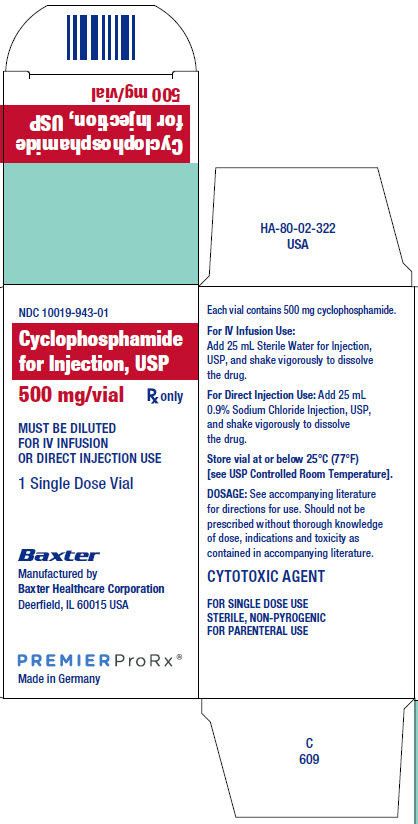![Cyclophosphamide Injection, Powder, For Solution [Baxter Healthcare Corporation] Cyclophosphamide Injection, Powder, For Solution [Baxter Healthcare Corporation]](/wp-content/themes/bootstrap/assets/img/loading2.gif)
During or immediately after the administration, adequate amounts of fluid should be ingested or infused to force diuresis in order to reduce the risk of urinary tract toxicity. Therefore, cyclophosphamide should be administered in the morning.
2.1 Dosing of Malignant Diseases
Adults and Pediatric Patients
Intravenous
When used as the only oncolytic drug therapy, the initial course of cyclophosphamide for patients with no hematologic deficiency usually consists of 40 mg per kg to 50 mg per kg given intravenously in divided doses over a period of 2 to 5 days. Other intravenous regimens include 10 mg per kg to 15 mg per kg given every 7 to 10 days or 3 mg per kg to 5 mg per kg twice weekly.
Oral
Oral cyclophosphamide dosing is usually in the range of 1 mg per kg per day to 5 mg per kg per day for both initial and maintenance dosing.
Many other regimens of intravenous and oral cyclophosphamide have been reported. Dosages must be adjusted in accord with evidence of antitumor activity and/or leukopenia. The total leukocyte count is a good, objective guide for regulating dosage.
When cyclophosphamide is included in combined cytotoxic regimens, it may be necessary to reduce the dose of cyclophosphamide as well as that of the other drugs.
2.2 Dosing for Minimal Change Nephrotic Syndrome in Pediatric Patients
An oral dose of 2 mg per kg daily for 8 to 12 weeks (maximum cumulative dose 168 mg per kg) is recommended. Treatment beyond 90 days increases the probability of sterility in males [see Use in Specific Populations (8.4)].
2.3 Preparation, Handling and Administration
Handle and dispose of cyclophosphamide in a manner consistent with other cytotoxic drugs.1 Caution should be exercised when handling and preparing Cyclophosphamide for Injection, USP. To minimize the risk of dermal exposure, always wear gloves when handling vials containing Cyclophosphamide for Injection, USP.
Cyclophosphamide for Injection, USP
Intravenous Administration
Parenteral drug products should be inspected visually for particulate matter and discoloration prior to administration, whenever solution and container permit. Do not use cyclophosphamide vials if there are signs of melting. Melted cyclophosphamide is a clear or yellowish viscous liquid usually found as a connected phase or in droplets in the affected vials.
Cyclophosphamide does not contain any antimicrobial preservative and thus care must be taken to assure the sterility of prepared solutions. Use aseptic technique.
For Direct Intravenous Injection
Reconstitute Cyclophosphamide with 0.9% Sodium Chloride Injection, USP only, using the volumes listed below in Table 1. Gently swirl the vial to dissolve the drug completely. Do not use Sterile Water for Injection, USP because it results in a hypotonic solution and should not be injected directly.
Table 1: Reconstitution for Direct Intravenous Injection
Strength
Volume of
0.9% Sodium Chloride
Cyclophosphamide Concentration
500 mg
25 mL
20 mg per mL
1 g
50 mL
2 g
100 mL
For Intravenous Infusion
Reconstitution of Cyclophosphamide:
Reconstitute Cyclophosphamide using 0.9% Sodium Chloride Injection, USP or Sterile Water for Injection, USP with the volume of diluent listed below in Table 2. Add the diluent to the vial and gently swirl to dissolve the drug completely.
Table 2: Reconstitution in preparation for Intravenous Infusion
Strength
Volume of Diluent
Cyclophosphamide
Concentration
500 mg
25 mL
1 g
50 mL
20 mg per mL
2 g
100 mL
Dilution of Reconstituted Cyclophosphamide:
Further dilute the reconstituted Cyclophosphamide solution to a minimum concentration of 2 mg per mL with any of the following diluents:
•
5% Dextrose Injection, USP
•
5% Dextrose and 0.9% Sodium Chloride Injection, USP
•
0.45% Sodium Chloride Injection, USP
To reduce the likelihood of adverse reactions that appear to be administration rate-dependent (e.g., facial swelling, headache, nasal congestion, scalp burning), cyclophosphamide should be injected or infused very slowly. Duration of the infusion also should be appropriate for the volume and type of carrier fluid to be infused.
Storage of Reconstituted and Diluted Cyclophosphamide Solution:
If not used immediately, for microbiological integrity, cyclophosphamide solutions should be stored as described in Table 3.
Table 3: Storage of Cyclophosphamide Solutions
*
Storage time is the total time cyclophosphamide is in solution including the time it is reconstituted in 0.9% Sterile Sodium Chloride Injection, USP or Sterile Water for Injection, USP.
Diluent
Storage
Room Temperature
Refrigerated
Reconstituted Solution (Without Further Dilution)
0.9% Sodium Chloride Injection, USP
up to 24 hrs
Up to 6 days
Sterile Water for Injection, USP
Do not store; use immediately
Diluted Solutions*
0.45% Sodium Chloride Injection, USP
up to 24 hrs
up to 6 days
5% Dextrose Injection, USP
up to 24 hrs
up to 36 hrs
5% Dextrose and 0.9% Sodium Chloride Injection, USP
up to 24 hrs
up to 36 hrs
Use of Reconstituted Solution for Oral Administration
Liquid preparations of cyclophosphamide for oral administration may be prepared by dissolving cyclophosphamide for injection in Aromatic Elixir, National Formulary (NF). Such preparations should be stored under refrigeration in glass containers and used within 14 days.



![Cyclophosphamide Injection, Powder, For Solution [Baxter Healthcare Corporation]](http://dailymed.nlm.nih.gov/dailymed/image.cfm?setid=9ad8fc82-5316-41d4-b76f-a926bde27405&name=HT_16oz_PF_final.jpg)
![Cyclophosphamide Injection, Powder, For Solution [Baxter Healthcare Corporation]](http://dailymed.nlm.nih.gov/dailymed/image.cfm?setid=6d94f911-d751-45e4-b24d-8d85c6a3cefb&name=1-Box_PCConcentrate_15mL.jpg)
![Cyclophosphamide Tablet [Physicians Total Care, Inc.]](http://dailymed.nlm.nih.gov/dailymed/image.cfm?setid=15d30249-4714-4b13-b8ca-5dff38424282&name=5005.jpg)
![Cyclophosphamide Injection, Powder, Lyophilized, For Solution [Baxter Healthcare Corporation]](http://dailymed.nlm.nih.gov/dailymed/image.cfm?setid=369e6911-66bd-4544-9901-cf887fdf1dc2&name=38c490bd-6282-44a1-a6fa-b040b6b113a7-02.jpg)
![Cyclophosphamide Injection, Powder, For Solution [Baxter Healthcare Corporation]](http://dailymed.nlm.nih.gov/dailymed/image.cfm?setid=591d9955-3d9c-4cdc-a308-2f1288376b9f&name=image-02.jpg)
![Cyclophosphamide Capsule [Roxane Laboratories, Inc.]](http://dailymed.nlm.nih.gov/dailymed/image.cfm?setid=8135b917-882f-4b4c-99b7-fa8ea54af4bf&name=bd1316c9-f0e9-4e70-bef9-6bd57722d499-02.jpg)